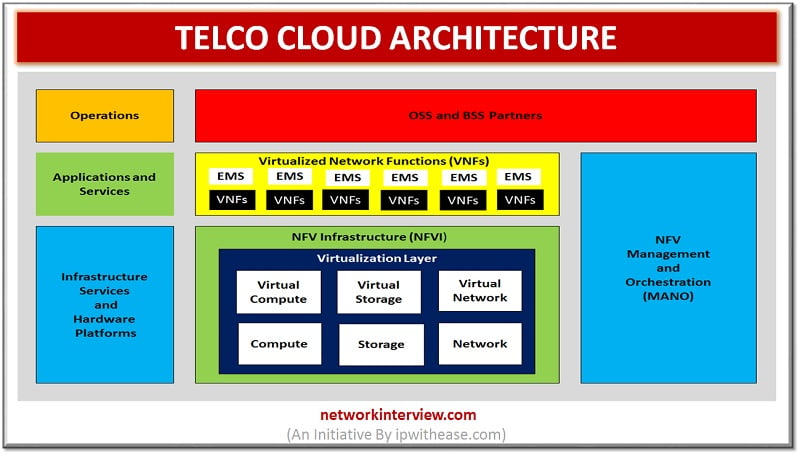
Telco Cloud Architecture
Telco Cloud Architecture
Table of Content:
- Definition of TelcoCloud
- Definition of Network Function Virtualization (NFV)
- NFV Architecture
- Benefits of NFV
- Application of NFV
- Conclusion
Definition of Telco Cloud
Telco cloud represents the Data Center resources which are required to deploy and manage a mobile phone network. Telco clouds are based in private Data Center facilities which are used to manage the telecommunication requirements of 3G/4G and LTE networks. With the current roll-out of 5G equipment across the mobile service provider, vendors have adopted strategies related to network function virtualization (NFV) and software-defined data center (SDDC) management which have become indispensable part of a telco setup.
Related – Telco Cloud vs IT Cloud
Definition of Network Function Virtualization (NFV)
Network functions virtualization (NFV) is a way to virtualize network services, such as routers, firewalls, and load balancers, that have traditionally been run on proprietary hardware or dedicated hardware. NFV’s functions like routing, load balancing and firewalls are packaged as virtual machines (VMs). NFV doesn’t depend on dedicated hardware for each network function. NFV improves scalability and agility by allowing service providers to deliver new network services and applications on demand, without requiring additional hardware resource.
Related – SDN vs NFV
NFV Architecture – A Telco Cloud Architecture
The NFV architecture was proposed by the European Telecommunications Standards Institute (ETSI) which has helped to define standards for NFV implementation. Each component of the architecture is based on these standards with approach to promote better stability and interoperability. NFV architecture consists of:
- Virtualization Network Function (VNF) Layer
- NFV Infrastructure (NFVI) Layer
- Operation Support Subsystem (OSS) Layer
- Management, Automation and Network Orchestration (MANO) Layer
Virtualization Network Function (VNF) Layer
Virtualized network functions (VNFs) are software applications that deliver network functions such as file sharing, directory services, and IP configuration. Virtual Network Function (VNF) is the key component of NFV Architecture. It virtualizes network function e.g. when a router is virtualized, it is known as a Router VNF and when a base station is virtualized it is known as a base station VNF. Similarly, it can be DHCP server VNF and Firewall VNF. When one sub-function of a network element is virtualized, it is known as a VNF. VNF is deployed on Virtual Machines (VMs). A VNF can be deployed on multiple VMs where each VM host performs a single function of VNF. However, the whole VNF can also be deployed on a single VM as well.
Element Management System (EMS) has capability for the functional management of VNF. It includes –
- Fault management
- Configuration management
- Accounting management
- Performance and Security Management.
Depending on infrastructure, there can be provision of one EMS per VNF or else one EMS that can manage multiple VNFs. EMS can be deployed as Virtual Network Function (VNF).
NFV Infrastructure (NFVI) Layer
Network functions virtualization infrastructure (NFVi) consists of the infrastructure components (compute, storage and networking) on a platform to support software, such as a hypervisor (like KVM) or a container management platform, needed to run network apps. NFV Infrastructure refers to the hardware and software components which build up the environment where VNFs are deployed, managed and executed. NFV Infrastructure includes following:
- Hardware Resources
- Virtualization Layer
- Virtual Resources
Operation Support Subsystem (OSS)/Business Support System (BSS) Layer
OSS deals with network management, fault management, configuration management and service management.
Management, Automation and Network Orchestration (MANO) Layer
Management, Automation and Network Orchestration (MANO) is responsible for managing NFV infrastructure and provisioning new VNFs. Management and Orchestration Layer is also abbreviated as MANO. Three components of this layer:
- Virtualized Infrastructure Manager
- VNF Manager
- Orchestrator
MANO interacts with both NFVI and VNF layer. It manages all the resources in the infrastructure layer, and also creates and deletes resources and manages their allocation of the VNFs.
Benefits of using NFV
- Reduced physical space required for network hardware.
- Reduced network power consumption.
- Reduced network maintenance costs.
- Easier network upgrades.
- Longer life cycle for network hardware.
- Reduced maintenance and hardware costs.
- Reduced physical hardware requirement.
- Increased flexibility to run VNFs across different servers or move them around as needed when demand changes.
- If the function is no longer needed, the VM can be decommissioned.
Application of NFV
- Mobile Edge Computing, this technology was born from the ongoing rollouts of 5G networks. The MEC uses individual components in its architecture which are similar to the NFV.
- Software Defined Wide Area Network (SD-WAN).
- Virtual Customer Premise Equipment (vCPE).
- Pre-NFV/SDN-based virtualized legacy infrastructure equipment.
- NFV telco Data Centers using SDN controllers.
- Evolved Packet Core (EPC).
Conclusion
Telco Cloud refers to a Private Cloud within a Telco/ISP environment. VNF functions are an imperative part of Telco Cloud and not extensively employed in enterprise Cloud or IT Cloud.
Tag:cloud



